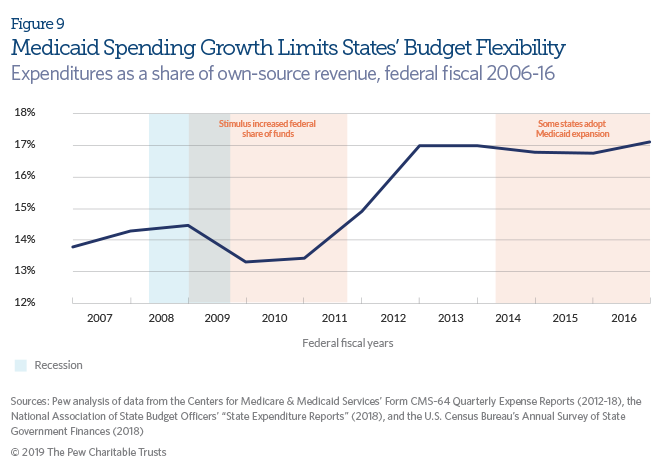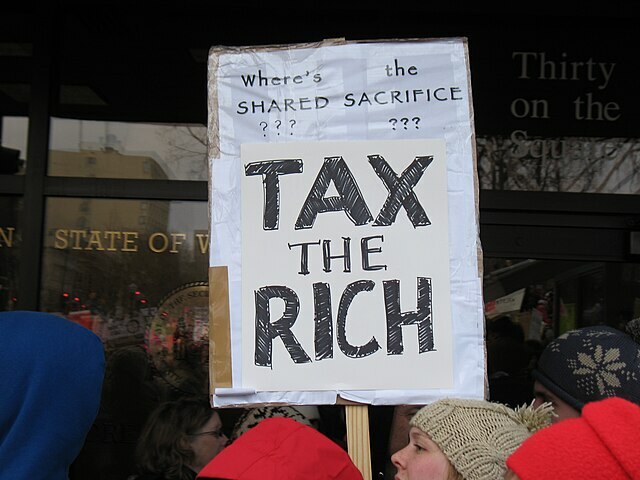A new budget for fiscal years 2019 and 2020 is currently working its way through the North Carolina General Assembly (See here and here for more). Lots of discussions during budget negotiations have focused on long term sustainability of the state budget. One of the sticking points between most Republicans and Democrats has been the issue of Medicaid expansion. As I have written before, expanding the Medicaid program to include all individuals up to 138% of the federal poverty level jeopardizes state budget sustainability.
During the Great Recession which started more than a decade ago, state spending on Medicaid in most states soared as more people became eligible. The federal government was able to provide considerable aid to mitigate the increased spending. However, the federal government has decreased the aid and Medicaid spending is still very high in most states despite almost a full recovery and very low unemployment. High Medicaid spending leaves little room in the budget for other priorities. This point is one of the topics in a new study conducted by Pew Research. This chart shows how the level of Medicaid spending has plateaued at a fairly high level compared to pre-recession spending:

On Medicaid state spending the report states:
Nationwide, Medicaid expenses accounted for 17.1 cents of every state-generated dollar in 2016, compared with 14.3 cents in 2007, just before the recession. Although the federal government covers at least half of the total costs of insuring Medicaid recipients, the portion shouldered by states is their second-biggest expense after K-12 education. Higher Medicaid costs can limit what states have left to fund other priorities, such as schools, transportation, and public safety.
Here is an excerpt of an interview conducted by Vox.com’s Dylan Scott with Barb Rosewicz, the leader of Pew’s state finances program, on the new report and Medicaid financing:
Dylan Scott
How would you describe the change we’ve seen with state budgets and with Medicaid specifically?
Barb Rosewicz
Even though the Great Recession seems far off, its legacy is still relevant in many of the challenges states face today. In fact, many states are still emerging from what can be called a lost decade for state finances. States are still dealing with consequences of decisions they had to make to survive the deepest recession since World War II. We find that on a 50-state basis, state support was still lower than before the recession for K-12 education, higher education, aid to local governments, and infrastructure. State workforces are smaller than they were before the recession.
Then at the same time, we look at instances where costs to states are higher than [they were] a decade ago. This is where Medicaid casts a big footprint. Unlike these other areas, this is one in which it’s harder for states to control the costs. When we compare where states were before the recession and where they are now, we take a look at how much of their own state revenue they are spending on Medicaid. Even though the federal government and states share it, we look at only the share states are spending from state-generated dollars. And what we find is Medicaid has taken up a larger share of state dollars since the recession.
Dylan Scott
So is this a new normal, especially once you consider a bunch of states expanded Medicaid and have to account for those costs going forward? Going forward into the future, do states just have to accept that Medicaid will take up a bigger chunk of their budgets than it had before? Or do we expect at some point that we’ll start to see a decline?
It almost seems hard to imagine at this point, because we’re in a long-running recovery with low unemployment and yet Medicaid spending is still high.
Barb Rosewicz
One of the risks we point out for Medicaid and these other indicators of spending is that if another recession hits before states have gone back to their pre-recession levels, it could cement in place these levels of spending.
Dylan Scott
So if we hit another recession before Medicaid spending falls back, the pressure on budgets will be significant? Is that one way to think about it?
Barb Rosewicz
One risk is that if these levels of spending for Medicaid and other areas stay where they are — and we found lower support for certain areas of spending and higher costs for other areas like Medicaid — then states will have less flexibility in dealing with another recession.
The lesson here is to exercise caution with spending and emphasize savings in the state budget. Reasonable growth in spending is one thing, but to rapidly increase long-term state obligations (i.e., Medicaid expansion) could prove to be costly amid another recession.


